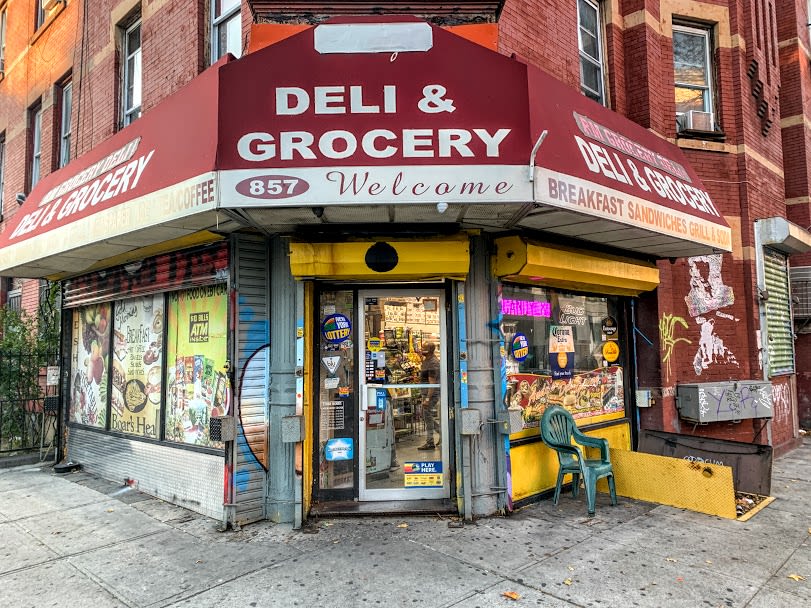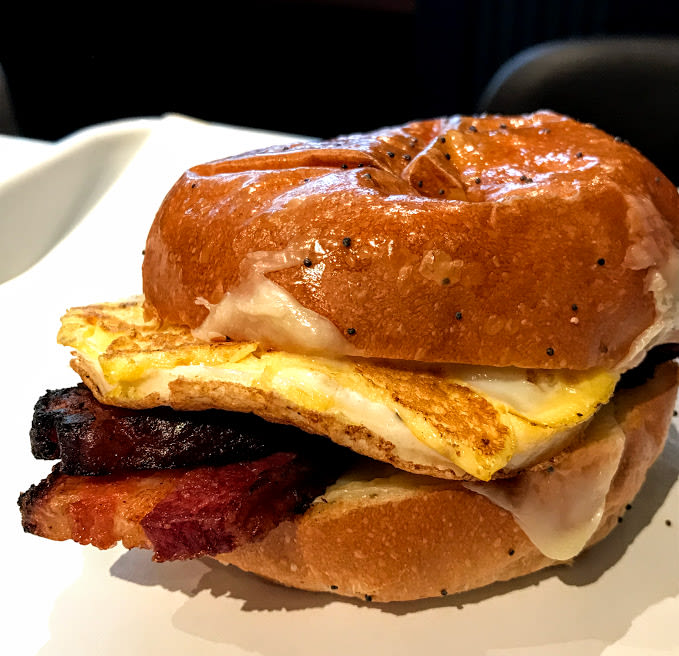The bacon, egg, and cheese (BEC) is a beloved sandwich across New York City. Despite consisting of ingredients that are dear to Hungarians’ hearts and stomachs, Budapest hasn’t yet discovered this wonderful street food. It’s high time that it did.

Most would agree that Budapest’s food offerings have improved tremendously over the past decade. Craving a hearty beef pho? In the mood for a beautifully charred and puffy Naples-style pizza? Feel like sipping on an expertly prepared Penicillin cocktail before calling it a night? Not a problem. And yet on a recent morning after returning from a trip to New York, I suddenly realized what was still painfully absent from Budapest: the bacon egg and cheese sandwich.

For many New Yorkers, most days begin with a bacon, egg and cheese, also known as a BEC. The sandwich is a work of magic: folded into a soft bread roll are strips of perfectly crisped bacon and two scrambled eggs coated in a still-melting slice of American cheese. A simple and delicious flavor bomb. The BEC’s excellence has less to do with the quality than the combination of its ingredients — no need to use fancy cheese or bacon here.
The absolute farthest you can go to elevate the BEC without committing sacrilege is adding a blob of ketchup for an additional burst of umami, or substituting the bread roll with a bagel. “The sandwich makes the first few hours of the working day in New York City possible,” writes New York Times restaurant critic, Pete Wells, of the city’s beloved egg sandwich.
Grabbing a BEC in New York is a quick and seamless exercise. They’re freshly made to order in sandwich shops, delis, or, more often, in neighborhood convenience stores called bodegas (which, technically, are different from delis). Bodegas dot every residential neighborhood; there's one on almost every corner.
The drill is simple: When it’s your turn, you yell your order to the man — it’s almost always a man — behind the counter, who is cracking eggs, crisping bacon, and melting cheese on a sizzling griddle with incredible efficiency. Then you walk over to the cashier, where you receive your hot sandwich double wrapped in wax paper and aluminum foil, placed in a brown bag along with an unreasonably thick pile of napkins. You’ll usually be in and out in less than five minutes.
It’s all very efficient. In fact, in fast-paced New York, it’s common to see people wolfing down their BECs en route to the subway, arriving to work with a full stomach. Apart from the BEC, other popular orders include ham, egg, and cheese; sausage, egg, and cheese; and the vegetarian egg and cheese roll.

A bodega is a notoriously democratic institution. Residents from the local public housing projects and hip millennials often line up side by side for their go-to morning BECs. Part of this is thanks to the egg sandwich somehow remaining unaffected by the food price inflation plaguing New York — I usually pay around three dollars for a BEC, which feels like a bargain in a city where an avocado toast runs fifteen dollars in the hyped places.
Note that most bodegas are owned by immigrants, and several Muslim proprietors swap pork for turkey bacon (my experience is that the best BECs are made in bodegas where the owners are from pork-eating Latin America).
Another great thing about bodegas is they serve egg sandwiches around the clock. This comes especially in handy after a night of drinking; the desperate attempt to mop up the alcohol with a BEC somehow feels less intrusive than the 3 a.m. chicken-over-rice platter drenched in white sauce.

By now, I hope you’ll appreciate how acutely I felt the absence of the bacon, egg, and cheese when I returned to Budapest. What makes the sandwich’s non-existence in my homw town all the more surprising is that its four chief components — bacon, egg, cheese, bread roll — are everyday staples in Hungary. Pork is the most popular meat in the country (in fact, bacon is so dear to the hearts of Hungarians that bacon roasting, or szalonnasütés, is a traditional summer pastime), and locals eat meaningfully more eggs each year than the EU average.
Instead of a BEC, the fashionable breakfast spots that have recently popped up across Budapest tend to serve high-brow, pricey global favorites along the lines of avocado toast, açaí bowl, and spinach-and-ricotta omelette. No doubt, these places have brightened up the city’s breakfast scene, which was noticeably anemic just a few years ago. But, they also don’t solve my newfound problem when all I crave is a simple BEC on the odd Tuesday morning (or night).
There are understandable reasons behind the BEC’s absence. Historically, Hungarians haven’t eaten breakfast outside the family home (it’s actually tourists who fill most of the new breakfast joints). This is a legacy of the Communist era (1947-1989), when few people could afford to dine out and hence hardly any restaurants catered to morning eaters.
Second, delis or their equivalents don’t exist in Hungary. International supermarket chains dominate almost every pocket of Budapest, and coffeehouses or the few mom-and-pop convenience stores that have survived limit their hot food offerings to the occasional sausages and toasted ham-and-cheese sandwiches; preparing eggs and crisping bacon requires space and investing in a griddle.

Instead of a BEC, a typical Hungarian breakfast consists of anything from cereal to an open-faced sandwich with toppings that are sweet (jam or a honey-butter spread) or savory (salami and cheese). Scrambled eggs drizzled with thin slices of paprika-laced sausage are also popular. When not fueling up at home, sweet breakfast pastries are common on-the-go choices, like the kakaós csiga, a chocolate bun shaped in a spiral, and the túrós táska, a roll filled with sweet-tart cottage cheese. Don’t get me wrong, I love all of the above, I just wish the choices also included a BEC.
Currently, gyros and pizza slices are the two most popular on-the-go snacks embraced by Budapest locals — the city is swarming with overlit slice shops and gyro vendors hawking low-priced but bland food. I’m convinced that a bacon, egg, and cheese joint would knock these out of the park. A BEC doesn’t take much longer to prepare than a gyro, and its price point is comparably low.

All this is to say that I, not entirely selflessly, view an attractive market opportunity for the BEC. This is my call for action to all budding Budapest-based entrepreneurs out there: Open an all-day egg sandwich shop! BEC-hungry American tourists will likely patronize your business initially, and there will be no turning back when local Hungarians come to know the depth of flavor and unique texture combination of this wonderful sandwich creation.
I should also note that recently some higher end, prestigious New York breakfast restaurants, like Daily Provisions, Win Son Bakery, and Bourke Street Bakery, have started to serve "updated" BECs to their customers, sliding artisanal bacon and cheese inside beautifully toasted brioche buns. These sandwiches are meaningfully pricier than bodega BECs, but extremely tasty. So, despite my earlier warnings of keeping the ingredients simple, you could also introduce a “VIP version” made from Hungarian Mangalica bacon. And if you get it right, you’ll certainly be able to count on at least one very regular customer.